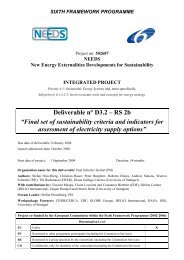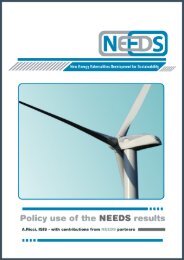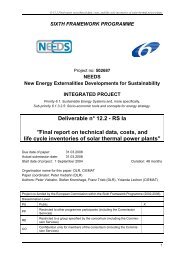Generation, of the energy carrier HYDROGEN In context ... - needs
Generation, of the energy carrier HYDROGEN In context ... - needs
Generation, of the energy carrier HYDROGEN In context ... - needs
You also want an ePaper? Increase the reach of your titles
YUMPU automatically turns print PDFs into web optimized ePapers that Google loves.
NyOrka Page 9 12/18/2008conductivity, and are referred to as alkaline electrolyzers. These units can be ei<strong>the</strong>runipolar or bipolar. The unipolar electrolyser resembles a tank and has electrodesconnected in parallel. A membrane is placed between <strong>the</strong> cathode and anode, whichseparate <strong>the</strong> hydrogen and oxygen as <strong>the</strong> gasses are produced, but allows <strong>the</strong> transfer<strong>of</strong> ions. The bipolar design resembles a filter press. Electrolysis cells are connected inseries, and hydrogen is produced on one side <strong>of</strong> <strong>the</strong> cell, oxygen on <strong>the</strong> o<strong>the</strong>r. Again, amembrane separates <strong>the</strong> electrodes.The third type <strong>of</strong> electrolysis unit is a Solid Polymer Electrolyte (SPE) electrolyser.These systems are also referred to as PEM or Proton Exchange Membraneelectrolysers. <strong>In</strong> this unit <strong>the</strong> electrolyte is a solid ion conducting membrane asopposed to <strong>the</strong> aqueous solution in <strong>the</strong> alkaline electrolyser. The membrane allows <strong>the</strong>H+ ion to transfer from <strong>the</strong> anode side <strong>of</strong> <strong>the</strong> membrane to <strong>the</strong> cathode side, where itforms hydrogen. The SPE membrane also serves to separate <strong>the</strong> hydrogen and oxygengasses, as oxygen is produced at <strong>the</strong> anode on one side <strong>of</strong> <strong>the</strong> membrane and hydrogenis produced on <strong>the</strong> opposite side <strong>of</strong> <strong>the</strong> membrane.Electrolytic units are currently capable <strong>of</strong> producing <strong>the</strong> largest amounts <strong>of</strong> hydrogen, andtoday are in use worldwide mostly <strong>the</strong> lye based technology, <strong>the</strong> selected case for <strong>the</strong>NEEDS . The LCA analysis is based on The PEM electrolysis unit is <strong>the</strong> newest <strong>of</strong> <strong>the</strong>technologies and is <strong>the</strong> cleanest candidate for future hydrogen production. Because <strong>the</strong>similarities with PEM fuel cells and PEM electrolyser it is foreseen that this unit willdevelop into <strong>the</strong> same unit: A reversible fuel cell! It is used for electrolysis to producehydrogen AND for <strong>the</strong> electric production from hydrogen. Prototypes <strong>of</strong> <strong>the</strong>se are2.3 Process description <strong>of</strong> electrolysisRegardless <strong>of</strong> <strong>the</strong> technology, <strong>the</strong> overall electrolysis reaction is <strong>the</strong> same:H 2O → ½ O 2+ H 2Figure 2 A schematic overview <strong>of</strong> <strong>the</strong> process flow within <strong>the</strong> three main types <strong>of</strong> electrolysis







